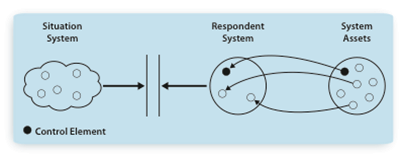Difference between revisions of "Overview of the Systems Approach"
| Line 35: | Line 35: | ||
====Article Discussion==== | ====Article Discussion==== | ||
[[{{TALKPAGENAME}}|[Go to discussion page]]] | [[{{TALKPAGENAME}}|[Go to discussion page]]] | ||
| − | <center>[[Systems Approach|<- Previous Article]] | [[Systems Approach|Parent Article]] | [[Exploring a Problem or Opportunity|Next Article ->]] | + | <center>[[Systems Approach|<- Previous Article]] | [[Systems Approach|Parent Article]] | [[Exploring a Problem or Opportunity|Next Article ->]]</center> |
| + | ==Signatures== | ||
[[Category:Part 2]][[Category:Topic]] | [[Category:Part 2]][[Category:Topic]] | ||
Revision as of 19:17, 9 August 2011
The Systems Approach must be viewed in the context of systems thinking as discussed by (Checkland, 1999) and by (Edson, 2008). According to (Checkland, 1999, p. 318), Systems Thinking is “an epistemology which, when applied to human activity is based on four basic ideas: emergence , hierarchy , communication, and control as characteristics of systems.” (Senge, 1990) provides an expanded definition as follows: “Systems thinking is a discipline for seeing wholes. It is a framework for seeing interrelationships rather than things, for seeing patterns of change rather than static "snapshots." It is a set of general principles -- distilled over the course of the twentieth century, spanning fields as diverse as the physical and social sciences, engineering, and management.... During the last thirty years, these tools have been applied to understand a wide range of corporate, urban, regional, economic, political, ecological, and even psychological systems. And systems thinking is a sensibility -- for the subtle interconnectedness that gives living systems their unique character”.
Systems Thinking has two parts. The first part is a set of concepts to assist in learning how to think in terms of systems. These principles were previously enumerated in the System Concepts topic. Edson (2008, p. 6) captures the primary principles by listing three conditions for a set of elements to satisfy to be a system: “(1) The behavior of each element has an effect on the behavior of the whole. (2) The behavior of the elements and their effects on the whole are interdependent. (3) elements of a system are so connected that independent subgroups of them cannot be formed.”
The second part of Systems Thinking is the how-to part. It is an abstract set of principles to apply Systems Thinking. This abstract set of principles is called the Systems Approach, the subject of this section. The Systems Approach can relate thinking to exploring the problem or opportunity and proceeding through the steps of system analysis , synthesis , proving the system, and incremental solutions to solve the problem or achieve the opportunity. Models suggested by (Checkland, 1999), (Boardman and Sauser, 2008), (Senge, 1990), and others are employed in this process. When this process is executed in the real world of human-made systems, the discipline of Systems Engineering emerges.
The relation between systems, Systems Thinking, the Systems Approach, and Systems Engineering can be found in Lawson (2010) where key aspects of the Systems Approach are identified as the mindset capabilities to “think” and “act” in terms of systems. The development of these capabilities is promoted by several paradigms including the following called the system coupling diagram :
- Situation System – The problem or opportunity situation; either unplanned or planned. The situation may be the work of nature, be man-made, a combination of both nature and man-made or a postulated situation that is to be used as a basis for deeper understanding and training (for example, business games or military exercises).
- Respondent System – The system created to respond to the situation where the parallel bars indicate that this system interacts with the situation and transforms the situation to a new situation. A Respondent System, based upon the situation that is being treated can have several names such as Project, Program, Mission, Task Force, or in a scientific context, Experiment. Note that one of the system elements of this system is a control element that directs the operation of the respondent system in its interaction with the situation. This element is based upon an instantiation of a Control System asset, for example a Command and Control System, or a control process of some form.
- System Assets – The sustained assets of one or more enterprises that are be utilized in responding to situations. System assets must be adequately life cycle managed so that when instantiated in a Respondent System will perform their function. These are the systems that are the primary objects for Systems Engineers. Examples of assets include concrete systems such as value added products or services, facilities, instruments and tools, abstract systems such as theories, knowledge, processes and methods.
This generic model portrays the essence of a system approach and is applicable to to Product Systems Engineering, Service Systems Engineering and Enterprise Systems Engineering. Further, it is quite clear that this forms the basis for Systems of Systems where System Assets from multiple actors are collected in a Respondent System that is responding to a situation.
Since the premise is that Systems Approach is a mind-set prerequisite to Systems Engineering, it can be said that projects and programs executed with this mind-set are more likely to solve the problem or achieve the opportunity identified in the beginning.
The Systems Approach is often invoked in applications beyond product systems. For example, Systems Approach may be used in the educational domain. According to (Biggs, 1993), the system of interest includes “the student, the classroom, the institution, and the community.”
References
Please make sure all references are listed alphabetically and are formatted according to the Chicago Manual of Style (15th ed). See the BKCASE Reference Guidance for additional information.
Citations
Primary References
All primary references should be listed in alphabetical order. Remember to identify primary references by creating an internal link using the ‘’’reference title only’’’ (title). Please do not include version numbers in the links.
Additional References
All additional references should be listed in alphabetical order.
